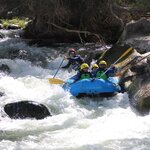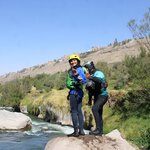Highlights
- Discover the "lost city of the Incas," Machu Picchu
- Hike through the surreal landscapes of Rainbow Mountain
- Boat around the floating islands of Lake Titicaca
- Ride a cable car high over the metropolis of La Paz
- Go on a Jeep tour through the largest salt flats in the world
Brief Itinerary
| Day | Highlights | Overnight |
|---|---|---|
| Day 1 | Arrive in Lima & Sightsee | Lima |
| Day 2 | Transfer to Cusco & Explore Pisac | Sacred Valley |
| Day 3 | Tour the Ruins of Machu Picchu | Sacred Valley |
| Day 4 | See the Ollantaytambo Fortress & Transfer to Cusco | Cusco |
| Day 5 | Hike Around Rainbow Mountain & the Red Valley | Cusco |
| Day 6 | Enjoy a Scenic Drive from Cusco to Puno | Puno |
| Day 7 | Sail to the Uros Floating Islands & Taquile | Puno |
| Day 8 | Fly from Puno to La Paz via Lima | La Paz |
| Day 9 | Discover the Ruins of Tiwanaku | La Paz |
| Day 10 | Travel from La Paz to Uyuni | Uyuni |
| Day 11 | Explore the Uyuni Salt Flats | Uyuni |
| Day 12 | Visit the Salt-Harvesting Capital of Colchani | Uyuni |
| Day 13 | Dine, Sightsee & Shop in La Paz | La Paz |
| Day 14 | Depart La Paz |
Detailed Itinerary
Day 1: Arrive in Lima & Sightsee

Welcome to Peru! Arrive in Lima and transfer to your hotel in Miraflores. You'll have the rest of the day free to relax and wander around at your own pace. The waterfront neighborhood is a wonderful place to spend the afternoon and evening. Walk on the clifftop promenade and sample traditional Peruvian dishes and drinks—ceviche with a pisco sour is a sure bet—in the district's many eateries. You'll sleep in Lima tonight before the trip continues tomorrow.
Day 2: Transfer to Cusco & Explore Pisac

This morning, catch a quick flight to the city of Cusco, the birthplace of the Incas and one of the world’s most beautiful and fascinating cities. You'll have time for a relaxed walking tour of Cusco’s historic center, visiting the Cathedral and Koricancha (Temple of the Sun) and the nearby ruins. After lunch, you'll drive through the sunny and scenic Sacred Valley, passing incredible terraces, ancient irrigation canals, and massive hilltop forts on the way to Pisac. Pisac’s bustling town square is home to the region’s largest and most famous craft market, and the surrounding streets are a maze of charming gardens, carved stone buildings, and hidden courtyards.
Day 3: Tour the Ruins of Machu Picchu

Get an early start today, heading to the Ollantaytambo train station to board the train to Aguas Calientes. The train journey is a spectacle in itself, offering beautiful scenery as you travel along the meandering Urubamba River. Upon arrival in Aguas Calientes, you'll board a bus for a short but steep ride up the winding road to Machu Picchu.
A spectacular stone city surrounded by incredibly steep green mountains, Machu Picchu needs no introduction: it's one of the new Seven Wonders of the World. Your tour guide will lead you on an unforgettable walk through the old city's stone-lined paths, along the terrace edges to the base of structures that testify to the extraordinary skill of its builders. For 400 years, the so-called "lost city of the Incas" remained hidden atop a mountain ridge until it was revealed to the world on the pages of "National Geographic" in 1911.
Day 4: See the Ollantaytambo Fortress & Transfer to Cusco

Enjoy breakfast at the hotel, then wander through charming Ollantaytambo, perhaps the most perfectly preserved of all Inca towns. Its cobblestoned alleyways and sun-drenched plazas are presided over by a spectacular llama-shaped ruin. Later, you'll return to Cusco for an afternoon of sightseeing. You'll tour ruins like Qenqo (where sacrifices were made), Puca Pucara, Tambomachay (also called "The Bath of the Inca"), and Sacsayhuaman Fortress, where Inca festivals like Inti Raymi and Warachicuy take place.
Dine at a Peruvian restaurant in the evening to sample local flavors and cooking techniques, including bread baked in earthen ovens.
Day 5: Hike Around Rainbow Mountain & the Red Valley

Leave Cusco early for a drive to the starting point of today's hike in the Ausangate Mountain Range. You'll begin a one-hour ascent up Vinicunca, or as most people know it, Rainbow Mountain. After enjoying the views from the top, you'll begin the descent to the Red Valley. Stop for a picnic lunch along the way. Then return to Cusco for a relaxing evening of dining, shopping, and wandering around cobblestoned streets.
Chat with a local specialist who can help organize your trip.
Day 6: Enjoy a Scenic Drive from Cusco to Puno

You'll drive to Puno today, visiting several interesting attractions along the way. First, you'll visit the famous Andahuaylillas Church, known as the "Sistine Chapel of America" because of its beautiful paintings. Continue along the route, enjoying breathtaking views of snow-capped mountains in the background, to Tambo Queque Norte, an Andean country manor that dates back to colonial times. You'll have lunch at the manor before proceeding to Tinajani Canyon to see peculiar rock formations and spectacular scenery. Overnight in Puno.
Day 7: Sail to the Uros Floating Islands & Taquile

Explore Lake Titicaca today, where you'll enjoy incredible scenery and see small farms and fishing villages. Your first stop will be at one of the floating islands of Uros. The local people live on floating manmade islands that are constructed out of the reeds that grow in abundance around the lake. During your visit to the islands, you'll learn about their everyday life and traditions. Afterward, have lunch at a local restaurant on Taquile Island, sampling quinoa soup and fresh fish caught in the lake. Then explore the island.
There are no cars here, and very little electricity. Taquile is famous for the exquisite weavings created by local artisans and the stunning views of Lake Titicaca from its shores. Later, you'll head back to Puno on a boat.
Day 8: Fly from Puno to La Paz via Lima

Catch an early flight out of Puno. Today you'll have your breath taken away (literally!) at 12,000 feet (3,658 meters) above sea level in La Paz, Bolivia. A colorful jumble of tradition and modernity where cholitas (Bolivian women in typical dress) travel in the world’s most modern urban gondola system, this one-of-a-kind city is a travelers' favorite.
Today you'll have time to explore the popular Witches' Market, where you can purchase medicinal herbs, and visit the San Francisco Cathedral, one of the oldest cathedrals in the city. You’ll see the main square, Plaza Murillo, and enjoy a thrilling cable car ride, taking in panoramic views of La Paz. Venture out to a restaurant in the evening to get a taste of traditional Bolivian cuisine.
Day 9: Discover the Ruins of Tiwanaku

After breakfast, travel to Tiwanaku, known as "the Cradle of American Man." This archaeological site is among the oldest in Andean history. Located near Lake Titicaca and partly surrounded by mountains and hills, the ancient city was built almost 13,000 feet (4000 meters) above sea level, making it one of the highest urban centers ever constructed. Tiwanaku reached its peak between roughly 500 and 1000 CE, when the population reached at least 10,000 people.
Only a small portion of the city, organized in a grid plan, has been excavated. You’ll visit the Pyramid of Akapana, the Temple of Kalasasaya, and the Door of the Sun. You will also have the opportunity to observe examples of ancient craftsmanship, including pottery from ceremonial vessels to incense burners. Return to La Paz in the evening and relax.
Day 10: Travel from La Paz to Uyuni

Early in the morning, you'll embark on a journey by car to the Salar de Uyuni salt flats. Start by visiting Uyuni's small salt museum (which was constructed with salt). Then you'll continue to tour the immense white expanse of the salar, or salt flats, stopping for one-of-a-kind photo ops as you go. Watch the sun go down over this one-of-a-kind landscape before getting some rest.
Day 11: Explore the Uyuni Salt Flats

Explore the salt flats again today with a Jeep tour around the area. You'll stop for photos, have time to walk around, and enjoy a picnic with an incredible backdrop. Finally, you'll visit the famed "train cemetery" that's filled with rusting train cars once used to transport minerals and people to and from Uyuni. Appreciate another impressive sunset over the Salar de Uyuni before dinner.
Day 12: Visit the Salt-Harvesting Capital of Colchani

This morning, after an early breakfast, you'll embark on one more day of Uyuni exploration. Enjoy a walk around the otherworldly Incahuasi Island. Covered in enormous cacti, it boasts amazing views of the flats. Continue onward to the salt-harvesting village of Colchani to see how the locals produce salt. You'll marvel at one last photo-worthy sunset over the salt flats before the next day's trip to La Paz.
Day 13: Dine, Sightsee & Shop in La Paz

Travel back to La Paz today. One option is to go on a culinary tour of the city, sampling unique Andean ingredients and cooking styles. You might sample a sanduíche de chola (pork sandwich), cuñapé (cheesy bread), or if you're feeling especially adventurous, anticucho (a skewer of beef heart with potatoes). Later in the day, head over to El Alto to catch a popular show featuring a wrestling match between cholitas—think native Andean culture meets the WWF. Enjoy one last Bolivian dinner and a night on the town in La Paz before the itinerary ends.
Day 14: Depart La Paz

It's time to say goodbye to Bolivia! After you have breakfast and spend a final morning enjoying La Paz, a driver will pick you up at your hotel and take you to the airport to catch your flight home. Safe travels!
More Great 14-Day Bolivia Itineraries
Looking for more inspiration for your trip to Bolivia? Check out these other 14-day Bolivia itineraries, with outdoor adventures, cultural trips, and best-of tours to hit the highlights.






